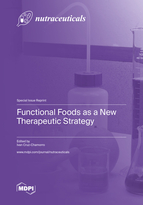Functional Foods as a New Therapeutic Strategy
A special issue of Nutraceuticals (ISSN 1661-3821).
Deadline for manuscript submissions: closed (31 December 2022) | Viewed by 55081
Special Issue Editor
Interests: functional foods; protein hydrolysate; antioxidant; immunomodulation; natural extracts; biopeptides; lupine; hemp
Special Issues, Collections and Topics in MDPI journals
Special Issue Information
Dear Colleagues,
Functional foods are a very interesting field that has recently increased its scientific production. Every day, researchers spend their time discovering the new healthy properties of foods. Thus, antioxidant, antihypertensive, anti-inflammatory, and antidiabetic effects, among others, had been demonstrated for these functional foods. These investigations were conducted in both in vitro and/or in vivo systems. The final goal of all these studies is to generate great and solid knowledge to prepare new functional foods that can be used by the human population to improve its lifestyle, without using synthesis-chemical compounds. Thus, functional foods are the present and the future in the prevention of several diseases.
However, there is too much to study yet and to discover. Therefore, this Special Issue of Nutraceuticals, entitled “Functional Foods as a New Therapeutic Strategy”, welcomes the submission of original articles or reviews that can improve the knowledge about the beneficial effects of functional foods.
Dr. Ivan Cruz-Chamorro
Guest Editor
Manuscript Submission Information
Manuscripts should be submitted online at www.mdpi.com by registering and logging in to this website. Once you are registered, click here to go to the submission form. Manuscripts can be submitted until the deadline. All submissions that pass pre-check are peer-reviewed. Accepted papers will be published continuously in the journal (as soon as accepted) and will be listed together on the special issue website. Research articles, review articles as well as short communications are invited. For planned papers, a title and short abstract (about 100 words) can be sent to the Editorial Office for announcement on this website.
Submitted manuscripts should not have been published previously, nor be under consideration for publication elsewhere (except conference proceedings papers). All manuscripts are thoroughly refereed through a single-blind peer-review process. A guide for authors and other relevant information for submission of manuscripts is available on the Instructions for Authors page. Nutraceuticals is an international peer-reviewed open access quarterly journal published by MDPI.
Please visit the Instructions for Authors page before submitting a manuscript. The Article Processing Charge (APC) for publication in this open access journal is 1000 CHF (Swiss Francs). Submitted papers should be well formatted and use good English. Authors may use MDPI's English editing service prior to publication or during author revisions.




